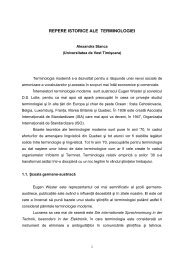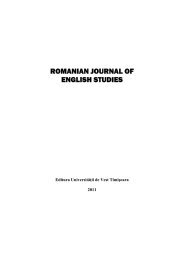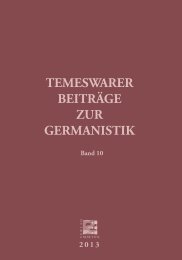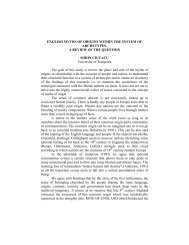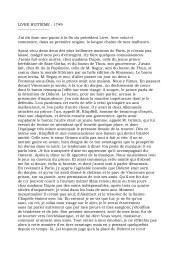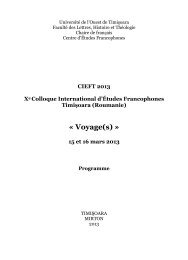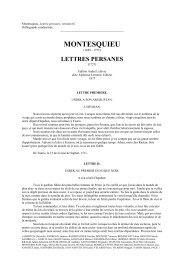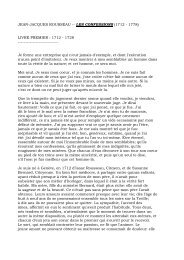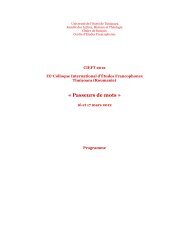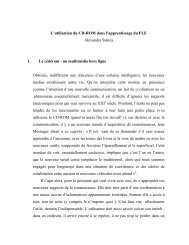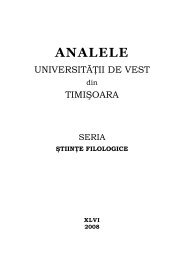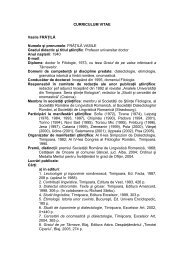TRANSLATION AND MEANING: A CULTURAL- COGNITIVE ...
TRANSLATION AND MEANING: A CULTURAL- COGNITIVE ...
TRANSLATION AND MEANING: A CULTURAL- COGNITIVE ...
You also want an ePaper? Increase the reach of your titles
YUMPU automatically turns print PDFs into web optimized ePapers that Google loves.
see theee stand”), epithets (“perfumed sea”, “desperate seas” “hyacinth<br />
hair”, “classic face”), two alliterations (“weary way-worn wanderer”, “glory<br />
that was Greece and the grandeur…”). Syntactical repetition prevails in the<br />
second stanza following two patterns: “thy hyacinth hair, thy classic face,<br />
thy Naiad airs” and “the glory that was Greece … the grandeur that was<br />
Rome”. Each five-line stanza is made up of iambic tetrameters, which<br />
alternate in the last line of the first stanza and the last two lines of the<br />
second stanza with trochaic tetrameters as well as with a trochaic dimeter in<br />
the last line of the last stanza. The rhyme differs in every stanza, combining<br />
alternate and enclosing rhymes: ababb in the first stanza, ababa in the<br />
second and abbab in the third. The vocabulary of the poem includes, besides<br />
words related to classical culture, the old forms of the personal pronoun<br />
(“thy”, “thee”) as well as the old poetic adverb “yore”, associated with<br />
another old word, the noun “barks”. The stress is laid on nouns with visual<br />
connection, either real or virtual, because the poet intends to present a static<br />
image of eternal beauty.<br />
4. An analysis of the four selected versions<br />
The four versions are not arranged in a chronological order but in a<br />
“metrical” order: the first two versions have a metrical pattern which is little<br />
connected to the metrical code of the original. The third and fourth versions<br />
try to render as closely as possible the metrical pattern of the original poem.<br />
We shall mainly analyse the four versions in point of loss and gain on the<br />
semantic, stylistical and prosodic levels.<br />
The first stanza starts with a direct invocation of Helen, which is<br />
preserved in all four Romanian versions. The noun “bark” has an archaic<br />
and poetic use, just like the adverb “yore”. A good translation of this noun is<br />
offered in versions 2 and 3 by “luntre”. “Corabie” and “vapor” used in<br />
versions 1 and, respectively, 2 belong to the same semantic area, but are not<br />
so rich in connotations. The Romanian noun “luntre” can be associated to<br />
the boat of the mythical Charon, who ferried the souls of the dead across the<br />
river Styx to Hades, therefore a ship which unites two opposed worlds. The<br />
equivalents of “barks” are used in the plural only in versions 1 and 2. As for<br />
the adverb “yore”, it is ignored in versions 3 and 4. Only versions 1 and 2<br />
give it a translation, “de-altădată” and “vreodat’ ” respectively. A better<br />
Romanian version would have been the poetic adverb “odinioară”, but it<br />
does not appear in any version. Anyway, reference to a past civilization is<br />
made with the help of the adjective “Nicean”, which is translated in all four<br />
versions.



